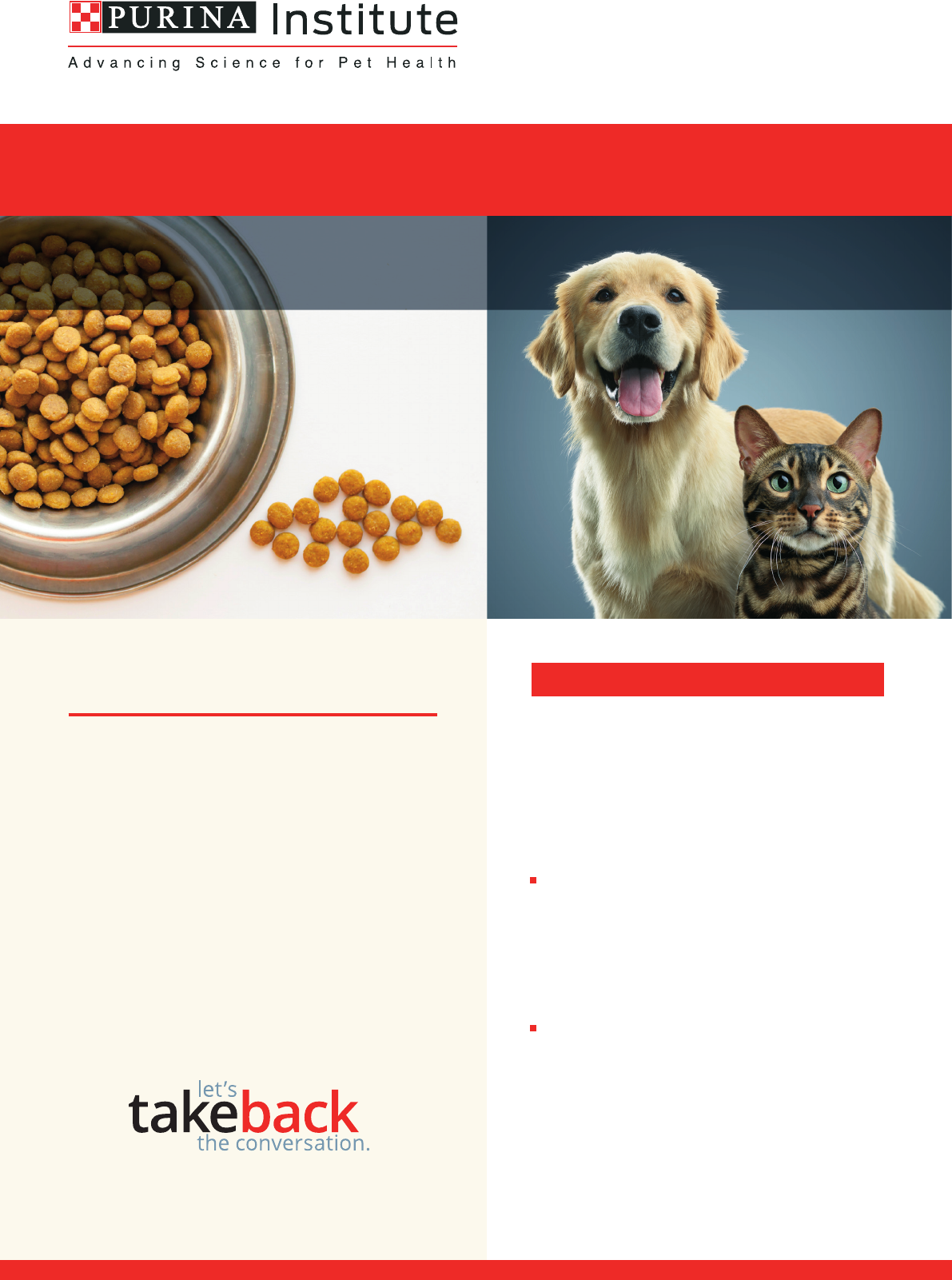
Learn more about the power of nutrition at
PurinaInstitute.com
Feeding guidelines are designed to
help owners determine the quantity
of food to feed their pets to ensure an
optimal body condition, but owners
may be unsure how to use them.
The Purina Institute provides the
scientic facts to support your
nutritional conversations.
In focus
Feeding guidelines on pet food labels
How to use feeding guidelines
HOT TOPIC
Pet food regulations require that all pet foods labeled
as ‘complete and balanced’
1
or ‘complete pet food’
2
must include feeding guidelines on the label.
3
Many
commercial treats and snacks will also provide feeding
guidelines regarding how many to feed per day.
Key points to remember:
• Since the calorie content of all pet foods diers
(i.e., some dry complete pet foods can vary in calorie
content by as much as 30%), it is important to check
the guidelines on the label, particularly when starting
a pet on a new food. The recommended daily feeding
amount can then be divided into the preferred number
of meals per day.
• Feeding guidelines are calculated based on the calorie
content of the food and the average calories a pet
needs, according to their body weight and life stage.
4
For example, puppies and kittens need more calories
per kilogram of body weight than an adult because
additional calories are required for growth.

References
1 Association of American Feed Control Ocials. (2019).
2019 Ocial Publication. Champagne, IL: Association of
American Feed Control Ocials, Inc.
2 FEDIAF European Pet Food Industry. (2018). Code of Good
Labelling Practice for Pet Food. Retrieved from http://
fediaf.org
3 Case, L. P., Daristotle, L., Hayek. M. G., & Raasch,
M. F. (2011). Canine and feline nutrition: A resource for
companion animal professionals. Mosby.
4 Yam, P. S., Naughton, G., Butowski, C. F., & Root, L. R.
(2017). Inaccurate assessment of canine body condition
score, body weight and pet food labels: a potential cause
of inaccurate feeding. Veterinary Sciences, 4(2), 30.
doi:10.3390/vetsci4020030
5 Bermingham, E. N., Thomas, D. G., Cave, N. J., Morris,
P. J., Butterwick, R. F., & German, A. J. (2014). Energy
requirements of adult dogs: a meta-analysis. PloS ONE,
9(10), e109681. doi:10.1371/journal.pone.0109681
6 Laamme, D. P. (1997). Development and validation of a
body condition score system for dogs. Canine Practice,
22(4), 10–15.
7 Laamme, D. P. (1997). Development and validation of
a body condition score system for cats: a clinical tool.
Feline Practice, 25(5-6), 13–18.
8 Aafco.org. (2017). Reading labels. Retrieved from http://
talkspetfood.aafco.org/readinglabels
How do you know you are feeding the
correct amount of food?
Regularly monitoring both the pet’s weight and body condition
using the Purina 9-point Body Condition Score system (available
for both dogs
6
and cats
7
) will indicate if the pet is receiving the
correct amount of calories for their individual needs. If a pet gains
or loses weight, feeding amounts can be adjusted as needed.
3
It is important to remember that
all treats and snacks add calories.
Therefore, the calories from treats
should be counted towards the total
daily calorie intake, reducing the
quantity of the main meal accordingly.
Feeding treats or small amounts of
human food can contribute a surprising
amount of calories, especially when
considering that dogs and cats need
signicantly less than ourselves.
Most manufacturers of treats and
snacks provide a guideline on how
many to feed per day. When feeding
a complete food it is generally
recommended that treats do not exceed
10% of a pet’s daily calorie intake.
8
Should the quantity of food be
adjusted when giving treats?
RA/CRCR
• The quantities stated in feeding guidelines are
based on an average pet and should be used as
a starting point to determine how much to feed.
Each pet is an individual and many factors, such as
their activity level, age, breed, reproductive status
and the environment in which they live,
3
can all
impact the amount of calories a pet needs.
Individual requirements can vary widely between
animals of the same body weight – sometimes as
much as 50%.
5
Less active adult pets may need fewer
calories to keep them at a healthy weight, whereas
more active pets of the same body weight will burn up
more calories and hence may need more food.
Feed amount recommended
in Feeding Guidelines
Monitor WEIGHT
and BODY CONDITION
ADJUST feeding
quantity accordingly
Observe waist behind ribs
Ribs palpable with slight fat covering
Abdominal fat pad minimal
Small piece of bacon =
10% daily calories
Small piece of cheese =
15% daily calories
Ribs easily palpable, with minimal
fat covering
Waist easily seen when viewed
from above
Abdomen tucked up when viewed
from the side
How an ideal body condition looks and feels:
10kg BWt
450 calories
/ day
4.5kg BWt
270 calories
/ day
